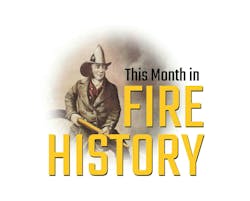October is Fire Prevention Month, highlighted, of course, by Fire Prevention Week, which this year is Oct. 6-12. As you probably know, Fire Prevention Week is observed each year during the week of Oct. 9 in commemoration of the Great Chicago Fire, which began on Oct. 8, 1871. But, did you know that an even bigger, more deadly fire broke out on the exact same day? Read about the Peshtigo Fire and other major October incidents below.
Oct. 8-9, 1871, Chicago—Great Chicago Fire
The Great Chicago Fire of 1871 burned through approximately 3.3 square miles, destroying more than 17,000 buildings and leaving more than 100,000 people homeless. Approximately 300 people died. The damage was estimated at $222 million (equivalent to about $5.7 billion in 2024).
Conditions were ripe in early October for a devasting conflagration. An extremely dry summer that recorded just one inch of rain combined with strong winds from the southwest. Fires had been popping up all summer. But Chicago was not prepared for what happened on Oct. 8.
In a story on Firehouse.com about the Chicago History Museum’s exhibit marking the 150th anniversary of the fire, Chicago Tribune reporter Talia Soglin wrote, “In 1871, Chicago was a city made of wood. Houses were built of wood; streets were paved with it. Water still ran through wooden pipes in parts of the city because the growing metropolis had not yet swapped them for iron.”
While the exact cause remains unknown, the fire is believed to have started in or near a barn on DeKoven Street (did anyone say Mrs. O’Leary’s cow?). The fire quickly spread north and east from its origin, jumping the Chicago River twice.
A meteorological phenomenon known as fire whirls, or "fire devils," created tornado-like effects that sent embers high into the air and across long distances, eventually destroying the city’s waterworks, leaving firefighters without a water supply.
The fire finally burned out late on Oct. 9, aided by rainfall.
As a result of the devastation, new building codes were implemented, requiring the use of fireproof materials like brick, stone, and limestone. The city experienced a "Great Rebuilding," which led to innovations in architecture and the construction of the first skyscrapers. Some of the lower-income residents were unable to afford to rebuild, which led to shifts in the city’s demographics.
Oct. 8, 1871, Peshtigo, WI—Peshtigo Fire
On the same day as the Great Chicago Fire, just 253 miles to the north, a devastating wildfire broke out in Peshtigo, WI. The Peshtigo Fire is considered the deadliest wildfire in recorded history, with estimated deaths between 1,500 and 2,500 people. Roughly 1.2 to 1.5 million acres of land burned, destroying 16 communities and 2 million trees, saplings and animals. Estimated property damage of $5 million (equivalent to about $127 million in 2024 dollars) was reported.
The fire burned much of the Door Peninsula and the Upper Peninsula of Michigan, but the largest affected community was Peshtigo, which had about 1,700 residents at the time.
As with the Great Chicago Fire, some of the same factors contributed to the catastrophic nature of the fire—namely prolonged drought conditions and unusually high winds.
But, unlike the big city, several other factors came into play, namely widespread land-clearing practices for logging and agriculture and small embers from slash and burn agriculture that got caught in strong drafts.
The timber industry and farming practices contributed significantly to the fire risk. Lumberjacks would clear areas and set fire to remaining debris or leave piles of woody fuel to dry and farmers set fires to clear fields and burn stump.
These factors collectively created a "tinderbox" situation, where small fires, coupled with unusually dry weather and strong winds, led to the formation of a devastating firestorm with temperatures reaching at least 2,000 degrees Fahrenheit and winds of 110 miles per hour or stronger.
The aftermath of the fire saw new less wasteful logging practices, moving away from the destructive slash-and-burn methods that contributed to the disaster.
The Peshtigo disaster also prompted the federal government to adopt new forest management programs, including the establishment of federal forestry programs and the creation of the Division of Forestry. By 1881, Congress expanded the office of Special Agent in the Department of Agriculture into the Division of Forestry, which later became the U.S. Forest Service.
Oct. 17, 1966, New York City—Wonder Drug Store Collapse
At 9:36 p.m. on Oct. 17, 1966, a fire was reported at the American Art Galleries, a four-story brownstone located at 7 East 22nd St. in the Flatiron District of New York City. The fire originated in the cellar of the art gallery, which contained highly flammable materials such as lacquer, paint, and finished wood frames.
Firefighters were unable to enter through the 22nd Street side due to intense smoke and heat, so they attempted to approach the fire through the Wonder Drug Store on 23rd Street, which shared a common cellar with the art gallery. At approximately 10:39 p.m., a large section of the drugstore's floor suddenly collapsed, killing 12 members of the FDNY. It was the deadliest day in FDNY history until the Sept. 11, 2001, attacks.
The collapse was due to many factors. Several years earlier, a load-bearing party wall that formed the border between the two buildings had been removed without proper approval from the building department. This modification severely weakened the overall structural support of the buildings. The removal of the wall created a shared cellar between the two buildings, which allowed the fire to spread more easily and intensify without the firefighters’ knowledge. The drugstore's floor construction (wooden beams covered by concrete and terrazzo) prevented firefighters from detecting the extreme heat below.
When the 15-by-35-foot section of the floor gave way, 10 FDNY firefighters fell through the floor into the burning cellar. Two additional firefighters on the first floor were killed in a flashover. Engine 18 was particularly devastated, losing all but two of its members in the tragedy.
The fire reached five alarms and took 14 hours to extinguish and recover the bodies of the fallen firefighters.
On Oct. 21, a massive funeral procession took place, with 10,000 firefighters lining Fifth Avenue as 10 firetrucks carried the coffins to separate services.
Deputy Chief Thomas A Reilly, Division 3
Battalion Chief Walter J Higgins, Battalion 7
Lt. John J Finley, Ladder 7
Lt. Joseph Priore, Engine 18
Firefighter John G Berry, Ladder 7
Firefighter James V Galanaugh, Engine 18
Firefighter Rudolph F Kaminsky, Ladder 7
Firefighter Joseph Kelly, Engine 18
Firefighter Carl Lee, Ladder 7
Firefighter William F McCarron, Division 3
Firefighter Daniel L Rey, Engine 18
Firefighter Bernard A Tepper, Engine 18
Oct. 19, 1991, Oakland/Berkeley, CA—The Oakland Firestorm
What started out as a small grass fire on private property in the Oakland hills on Oct. 19, 1991, turned into the largest wildland-urban interface fire in the Bay Area's history just one day later.
Initially, firefighters extinguished the small blaze, but smoldering embers reignited the next morning. Fanned by strong easterly winds, the fire quickly grew out of control and became a raging inferno. The fire consumed 2.5 square miles of mostly residential neighborhoods, killing 25 people (including Oakland Battalion Chief James Riley and Oakland police officer John Grubensky) and injuring 150 more. Roughly 3,500 homes and apartments were destroyed and 10,000 people were forced to evacuate. The fire caused an estimated $1.7 billion in damages.
More than 1,500 firefighters and 450 engines from all over Northern California took part in the firefighting efforts.
In a story that appeared on Firehouse.com, Deputy Chief James Williams, who had been with the Oakland Fire Department for just a year at the time, said “This was unlike any fire we'd ever seen before. We had a couple of places where some of our people who are now retired had to jump into pools for safe refuge, because the fire was blowing up over their heads.”
On the 25th anniversary of the fire, Firehouse.com shared a video clip from a location station.
Oct. 29, 2012, Eastern Seaboard—Superstorm Sandy
In late October 2012, a Category 3 hurricane formed off of the Atlantic seaboard. After moving through the Caribbean and intensifying, it transitioned into a post-tropical cyclone before hitting the coast. It caused massive damage up and down the East Coast of the United States, making landfall near Brigantine, NJ, around 7:30 p.m. on Oct. 29. The timing of its landfall coincided with high tide, exacerbating the storm surge and resulting in significant flooding and damage across affected areas, particularly in New York and New Jersey.
More than 100 people were killed, including 43 fatalities in New York City, where 6,500 patients had to be evacuated from hospitals and nursing homes; 90,000 buildings were in the inundation zone; 2 million New Yorkers were without power; and numerous major transit hubs flooded.
In his editor’s note for the January 2013 issue of Firehouse magazine, Harvey Eisner, as he so often did, encapsulated the event.
“A 500-mile-wide Hurricane named Sandy caused death and destruction from the Northeast to the Great Lakes at the end of October and beginning of November 2012. One of the worst storms to hit the area in three decades, it caused the worst flooding in some area in nearly 200 years.
“Emergency resources were stretched to the breaking point. Calls for fires and people trapped by rising water had to be written down and dispatched upon availability of apparatus finishing other emergency calls. Many acts of heroism by first responders may never be documented as thousands of people needing assistance were removed by first responders who went above and beyond the call of duty.
“Not only did they respond to pleas for help, but many first responders lost their homes, or they received extensive damage. These responders had no time to worry about their own families, but did what they had to do to get the job done during the storm. Here’s just one example: in one Ocean County, NJ, fire department, 37 of its 41 members lost their homes. In the same county, 40 of 140 fire stations apparently were destroyed or heavily damaged.”
In his “FDNY: A Reflection on the Past 20 Years” article for Firehouse, then-FDNY Chief of Department Thomas Richardson detailed the FDNY’s response to the disaster.
In 2023, Marty Ingram provided lessons learned during Superstorm Sandy, including the intricacies of weather alerts, operating apparatus in deep water and training in inclement weather.
Other Major Incidents This Month in Fire History
Oct. 12, 1918, Cloquet, MN—Forest fire kills 559
Oct. 22, 1913, Dawson, NM—Coal mine explosion, 263 died
Oct. 23, 1989, Pasadena, TX—Phillips Petroleum plant fire kills 23

Steven Shaw | Managing Editor, Firehouse.com
Steven Shaw is the managing editor of Firehouse.com. Shaw served as editorial director of the James H. Neal Award-winning “WTC: In Their Own Words” and “Hot Shots: Spectacular Fire Photos.” He previously served as editor-in-chief of Industrial Photography, The Commercial Image and Studio Photography and Design.






